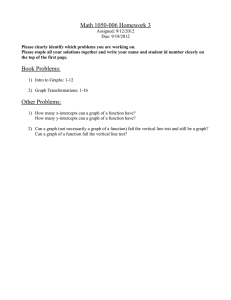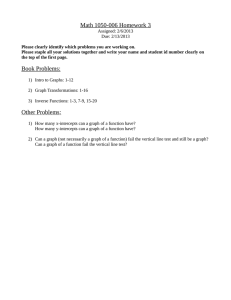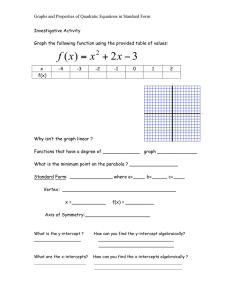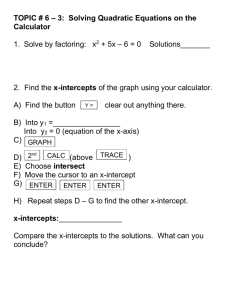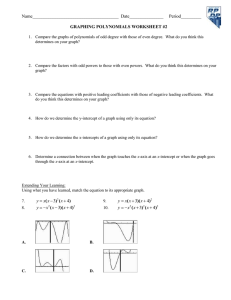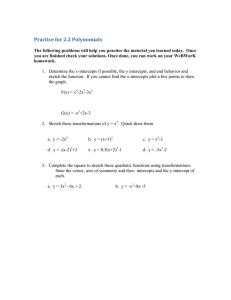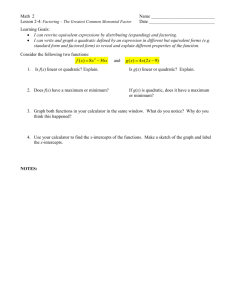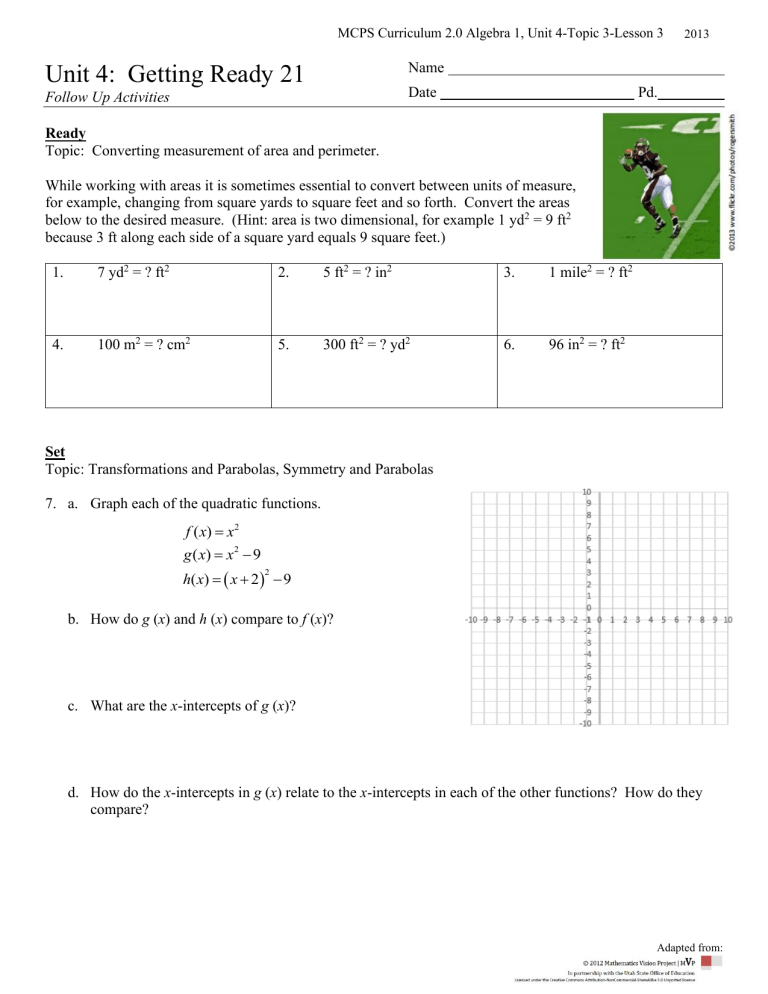
MCPS Curriculum 2.0 Algebra 1, Unit 4-Topic 3-Lesson 3 2013 Name Unit 4: Getting Ready 21 Date Follow Up Activities Pd. Ready Topic: Converting measurement of area and perimeter. While working with areas it is sometimes essential to convert between units of measure, for example, changing from square yards to square feet and so forth. Convert the areas below to the desired measure. (Hint: area is two dimensional, for example 1 yd2 = 9 ft2 because 3 ft along each side of a square yard equals 9 square feet.) 1. 7 yd2 = ? ft2 2. 5 ft2 = ? in2 3. 1 mile2 = ? ft2 4. 100 m2 = ? cm2 5. 300 ft2 = ? yd2 6. 96 in2 = ? ft2 Set Topic: Transformations and Parabolas, Symmetry and Parabolas 7. a. Graph each of the quadratic functions. f ( x) = x2 g ( x) = x 2 − 9 h( x) = ( x + 2) − 9 2 b. How do g (x) and h (x) compare to f (x)? c. What are the x-intercepts of g (x)? d. How do the x-intercepts in g (x) relate to the x-intercepts in each of the other functions? How do they compare? Adapted from: MCPS Curriculum 2.0 Algebra 1, Unit 4-Topic 3-Lesson 3 2013 8. a. Graph each of the quadratic functions. f ( x) = x2 g ( x) = x 2 − 4 h( x) = ( x − 1) − 4 2 b. How do g (x) and h (x) compare to f (x)? c. What are the x-intercepts of g (x)? d. How do the x-intercepts in g (x) relate to the x-intercepts in each of the other functions? How do they compare? 9. How can the transformations that occur to the function f ( x) = x2 be used to determine the x-intercepts of the function’s image? Adapted from: MCPS Curriculum 2.0 Algebra 1, Unit 4-Topic 3-Lesson 3 2013 Go Topic: Function Notation and Evaluating Functions Use the given functions to find the missing values. (Check your work using a graph.) 10. f ( x) = x2 + 4 x −12 11. g ( x) = ( x − 5) + 2 2 a. f (0) = ________ a. g (0) = _______ b. f (2) = ________ b. g (5) = _______ c. f (x) = 0, x = ______ c. g (x) = 0, x = ______ d. f (x) = 20, x = _____ d. g (x) = 16, x = _____ 12. f ( x) = x2 − 6 x + 9 13. g ( x) = ( x − 2) − 3 2 a. f (0) = ______ a. g (0) = _______ b. f (−3) = 0 b. g (5) = _______ c. f (x) = 0, x = _____ c. g (x) = 0, x = _____ d. f (x) = 16, x = _____ d. g (x) = −3 , x = ____ Adapted from: MCPS Curriculum 2.0 Algebra 1, Unit 4-Topic 3-Lesson 3 14. f ( x) = ( x + 5) 2 2013 15. g ( x) = − ( x + 1) + 8 2 a. f (0) = ______ a. g (0) = ________ b. f ( −2 ) = _____ b. g (2) = ________ c. f (x) = 0, x = ______ c. g (x) = 0, x = _______ d. f (x) = 9, x = ______ d. g (x) = 4, x = _______ Adapted from:
